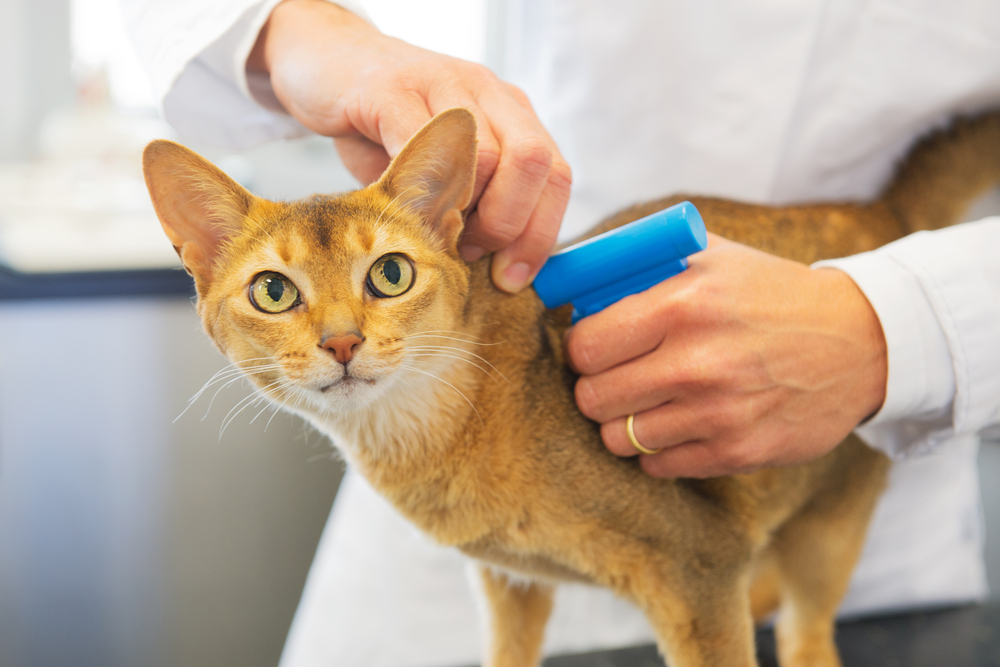Nothing is more heartbreaking than knowing your beloved pet is wandering lost and alone, with no means to find their way back home. Without a collar, ID tags, or a microchip, your pet may end up stuck in an animal shelter, or adopted by another family. In addition to ensuring a happy reunion with your lost pet, microchips provide plenty of perks.
#1: Many lost pets without identification end up in animal shelters
Millions of pets enter U.S. animal shelters each year but, according to the ASPCA, only about 710,000 are returned to their owners. Of these, only about 90,000 are cats. Many cats do not wear collars, since they are strictly house pets, but they can easily slip out an open door and become lost. Without a microchip, reuniting with your feline friend can be nearly impossible, especially if you own a cat with few identifying features. You may know your loving cat’s personality, but picking a short-haired black cat out of a shelter lineup can be difficult. If your pet sneaks out of your home or backyard without wearing a collar, a microchip may be the only way to ensure a happy reunion.
#2: Collar ID tags can fall off or become worn and illegible
Identification tags attached to a pet’s collar are the most common ID form, since they provide readily accessible contact info, but they are not a fail-safe. Collars can break, fall off, or be removed, while the tags can become worn and illegible, and too many problems are possible, to rely solely on these identification forms. Ideally, add a microchip to your pet’s collar ID tags, to provide multiple identification routes.
#3: Microchips provide the only permanent identification with a national database
While tattoos are also a permanent ID, cats and dogs are typically tattooed to mark sterilization, and not for identification, as in livestock. With a pet microchip, a database of all the registered microchips makes searching for the pet’s microchip registration company a breeze. Once an animal shelter or veterinary clinic scans a pet, the chip number that pops up can be entered into the database, the company contacted, and your phone number released, so you can be reunited with your pet. Ensure you update your contact information up if you relocate or change your phone number.
#4: A microchip offers more features than only permanent identification
Pet microchips are essential for permanent identification, but some microchips have special features. The microchip company, Home Again, offers microchip smart products, including pet feeders, and cat and dog doors, which operate based on a pet’s microchip, allowing access only to the particular pet. A microchip-operated pet feeder is ideal for a pet on a prescription diet, who would rather graze all day, rather than eat a full meal at one time, because the door to the food opens only for the pet with the linked microchip, and remains shut for other pets, and small children. The pet doors also work based on microchips, and can keep out stray pets or wildlife.
#5: A microchip cannot be removed and usually does not need to be replaced
While you can purchase and administer your pet’s microchip yourself, we strongly recommend that a veterinary professional performs this procedure, to ensure correct positioning.
Microchips do not contain any moving parts or batteries, so replacement is usually not necessary. Since microchips are made of biocompatible materials, they should last the life of your pet, without degradation. Unlike collars and ID tags, a microchip cannot fall out or be removed, unless inserted incorrectly. In rare cases, some microchips can be expelled from your pet’s body. Have your pet’s microchip scanned during each visit to your veterinarian, to ensure it is able to be located, and is reading properly.
#6: Your pet’s microchip does not give out your personal information
Pet owners may shy away from microchipping their pet, because they are worried that the chip will give away personal information, but that is not the case. A scanned microchip will emit only a number unique to your pet, which is then given to the microchip registration company, who will release your contact info, so you can be reunited with your beloved companion.
#7: A microchip is an economical form of identification for your pet
While microchips do not provide GPS tracking services, they are an economical identification form for your pet. You can purchase a GPS tracking collar, but many specialized collars with such high-end services come with a hefty price tag of hundreds or thousands of dollars. A pet microchip at Stack Veterinary Hospital is significantly more affordable, while the peace of mind it grants is priceless.
#8: A microchip can be inserted during your pet’s regular visit

Microchip insertion does not require sedation or anesthesia, so there is no reason we can’t microchip your furry friend at their next visit. One of our technicians can microchip your pet, saving you time and money.
With all its perks, you’ll wonder why you didn’t microchip your pet sooner. No worries—call us to schedule your pet’s microchip appointment, and help ensure a happy reunion, if your pal wanders off.







Leave A Comment